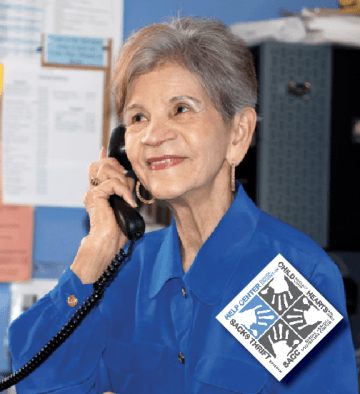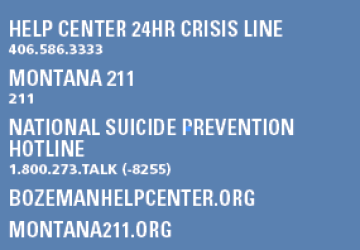Bozeman Help Center Celebrates 50 Years of Dedicated Service in the Gallatin Valley
On March 22, 2021, Help Center, Inc. celebrated 50 years of dedicated service to the Gallatin Valley and surrounding areas. I recently sat down with Mandy St. Aubyn, who is the Development and Communications Coordinator for Help Center, Inc. as we discussed the influence that Help Center, Inc. – as an umbrella – has provided to our local residents for these last five decades.
The Gallatin Council on Health and Drugs arose from a group of citizens who were concerned over the rise of drug usage that was coming to the Gallatin Valley, and was established as a nonprofit organization, made up of ordinary citizens who saw a chance to change things for the better and then seized upon that opportunity. It was in June of 1971 that the Help Center became an all-purpose crisis center, available 24 / 7 / 365. That first year of 1971, the Help Center took 1,593 calls inside a six-month span. Average that out and you are looking at about seven and a half calls per day. Fast forward to 2020 when the Help Center answered 12,342 calls, or almost 34 calls per day, and you are looking at an increase of almost seven-fold in the number of clients served in southwest Montana. Over time, that mission has evolved and logos have been redesigned, but always with the singular mission of keeping those in need in mind, and putting those unique needs first.
I asked St. Aubyn what the parameters were and the definitions of our community, as they pertain to Help Center, Inc. I learned that Help Center, Inc. serves a community that not only includes the Gallatin Valley, but a total of 13 communities in southwest Montana. Help Center, Inc. Anyone in southwest Montana can contact the Help Center, any time of the day or night. Staffed around the clock with no less than one staff member and sometimes as many as three to four volunteers, anyone in need can reach out. With the Help Center being a nationally accredited facility, the staff has access to a literal library of resources to assist those in need. Many of the volunteers and staff members have been there since the early days of the organization and that real-world experience brings a wealth of knowledge and layers of expertise to the table, St. Aubyn tells me.
If you are interested in becoming a volunteer, check out information on the Help Center, Inc. website. All volunteers go through a background check and no less than 20 to 40 hours of training. St. Aubyn tells me that there are no background prerequisites necessary, only an open heart and a willingness to serve the community at large.
It was in June of 2003 that the name of the agency was officially changed to Help Center, Inc., allowing the organization to grow and meet the continual and ever-changing needs of the community. These additions now include the flagship program of the Help Center, as well as hosting the Sexual Assault Counseling Center, the Gallatin County Child Advocacy Center, and the Hearts & Homes Family Resource Center. If this sounds like an enormous burden to shoulder, it is. Help Center, Inc. relies on donations as well as Sacks Thrift Store to offset that cost. It’s truly a community caring for its own.
The Sexual Assault Counseling Center was opened in 1996 and provides advocacy and counseling to those who are sexual assault survivors, as well as connecting them to other support systems.
The Gallatin County Child Advocacy Center, which was opened in 2015, provides advocacy and a child-friendly space that is warm and caring, giving children who have suffered abuse a chance and a place to report that abuse.
The Hearts & Homes program was merged with existing programs in 2012, and provides a supervised visitation program, alongside parental education classes.
Sacks Thrift Store provides financial support for Help Center, Inc. programs, including providing vouchers to various community members who are in need.
In addition to Sacks Thrift Store, Help Center, Inc. will be launching their “50 FOR 50” fundraising campaign. The aim of this goal is to celebrate the milestone anniversary of half a century of service by raising $50,000 and engage 50 new monthly donors within five months to support and sustain these vital resources. A link to the 50 FOR 50 campaign can be found on the Help Center, Inc. website.
Through all of this, St. Aubyn tells me that the mission has remained the same: Providing an effective, compassionate response to clients in crisis that is critical to the well-being of our community. Some of these responses include phone calls to check on home bound individuals, referrals to local resources and mental health options, in addition to education on a variety of topics including suicide prevention and healthy relationships.
As if 2020 wasn’t stressful enough, dealing with the worldwide pandemic of Covid 19, add to that a layer of anxiety and fear about the unknown with this virus, and it becomes readily apparent what a vital resource the Help Center is. The Help Center has seen an uptick in calls in excess of 50% in 2020 alone, giving out almost 4,900 referrals to various community services. Some of the major issues that were addressed through the Help Center included the following:
• 70% increase in calls concerning anxiety or fear
• 108% increase in calls concerning sleep problems
• 84% increase in calls concerning substance abuse
Development & Communications Coordinator Mandy St. Aubyn tells me that 2020 saw almost 800 calls more than they would have expected to receive, most of the uptick resulting from concerns of financial stress, housing or shelter, food, and economic instability. St. Aubyn notes that with every one of these calls, there was always a kind and compassionate voice on the line, ready to assist the client as best they could.
When the Bridger Foothills Fire ignited over 8,000 acres of wild land in September of 2020 – just to the northeast of Bozeman – Help Center 211 quickly activated to become a vital link for information taking 572 calls related to the fire.
In light of recent events in the media surrounding law enforcement and mental health crises, St. Aubyn tells me that Help Center, Inc. has even been proactively working with law enforcement, emergency services, and first responders – long before it became a media issue – to ensure that the unique and sensitive needs of each particular client were being met. So much so that in 2020, 86% of all callers who were experiencing a mental health crisis (including suicidal thoughts, intent, and/or active attempts) were actually stabilized due to their contact with the Help Center. Only 4% of callers required a dispatch of emergency services, and the remaining 10% had undisclosed dispositions.
What do the next 50 years look like? St. Aubyn tells me again, the mission remains the same. To provide information, outreach, digital services, advocacy, crisis counseling, as well as therapy to clientele in a safe and confidential environment. There is an expressed intent to assist clients in gaining insight, clarity, empowerment, client-centered solutions including life improvement skills in the wake of life’s difficulties in the aftermath of a traumatic event. No matter what the next 50 years brings, Help Center, Inc. will be there to create a sustainable infrastructure for a holistic approach to healing and safety for the communities that it has the privilege of serving.
If you, or someone you know, is experiencing a mental health crisis, do not hesitate to reach out for help. There are dedicated and caring individuals who will listen and provide those resources you may need.
